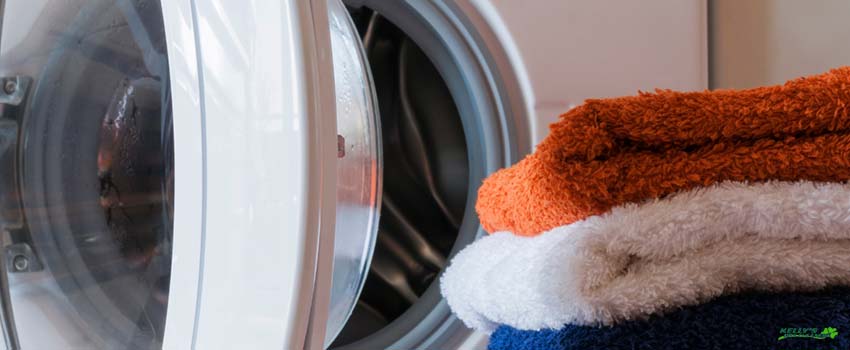Towel care may seem like a no-brainer, but if you want your towels to last, you must wash them properly.
You can laundry towels by throwing them in the washing machine, but this haphazard method makes your towels vulnerable to damage, not to mention they won’t be as fluffy as you’d hoped they would be. Following the guidelines in this article will ensure that your towels continue to look good and feel great even after repeated washings. Towels can be kept fresh and fluffy with careful washing and drying procedures that prevent musty odors and color degradation.
Follow this handy guide for invaluable laundry advice, including information on the best ways to wash towels, whether you can wash towels with clothes, and the best settings to use when washing towels of various colors and fibers.
How to Wash Towels The Right Way
1. Sort light and dark towels.
Separate towels into separate loads before washing them. White towels should never be washed with dark colors. Furthermore, because towels are so absorbent, the lighter-colored ones may absorb some of the dye colors from the darker ones, making them appear dingy or discolored.
2. Don’t overload the washing machine.
Avoid overloading the washing machine by placing too many towels in it. A conventional front-loading washing machine can accommodate about seven bath towels, whereas a top-loading machine can hold about ten.
3. Use less detergent.
Using too much laundry detergent will produce stiffness in your towels. Use approximately half of the recommended amount of laundry detergent for optimal results.
4. You can add bleach.
To clean white towels, use chlorine or color-safe bleach. If your towels have stains, bleach works well to remove them. Only color-safe bleach should be used when washing colored towels, as chlorine bleach will fade dark-colored towels.
5. Washing machine cycle.
You can wash your luxury towels in your machine on the standard or normal cycle. These cycles are great for cleaning towels because the faster spin and longer washing time compared to softer cycles help to clean dirt and bacteria from the towel’s fabric fibers.
6. Eliminate excess water before drying.
After washing the towels, remove them and shake off any excess water from each towel before placing them in the dryer. This reduces drying time and helps maintain the softness of the towels.
Ideal Temperature to Wash Towels
Laundry towels are comparatively delicate and should not be washed at scorching temperatures. By modifying the temperature at which towels are washed, you can profoundly affect your towel’s color, texture, and even durability. The suggested temperature is usually printed on the label of most towels.
Here are some general guidelines to follow when deciding what temperature to wash your towels at:
- Whites or light hues: Hot water aids in the preservation of the brightness of these light-colored towels.
- Colored or dark towels: Warm water is preferable for colored towels because hot water might cause the colors to bleed or fade.
- Decorative, microfiber, or delicate materials: While warm water is more effective for filthy towels, cold water is better for preserving the fabric’s integrity.
Washer Setting For Washing Towels
Several washer settings maybe available depending on the type of washing machine you have. Here are some suggestions regarding what settings to use:
Load Size Setting
The number of towels being washed determines the appropriate load size setting:
- Small load — one-quarter full
- Medium load — half full
- Heavy load — more than half full
- Extra-heavy load — washer is full
Cycle Option
The setting controls how each load will be washed and spun. Carefully read the label on your towel for detailed instructions. When selecting the ideal cycle for your towel load, keep the following in mind:
- Normal – This cycle features a high-speed wash and spin for normal load sizes.
- Heavy-duty – This is the most commonly used cycle for washing towels; it provides a longer wash cycle, fast agitation, and a high-speed spin to remove as much moisture as possible.
- Whites – Your white towels may occasionally require a white cycle that releases the bleach at the appropriate time during the cycle.
- Rinse and spin – For towels that are particularly filthy and require an additional detergent, adding a rinse and spin cycle helps clean them thoroughly.
Is it Ideal to Wash Clothes With Towels?
It is possible to spread germs and bacteria from one item of clothing to another by washing it together with towels. To ensure the highest level of hygiene, you should always wash bath towels separately from other articles of clothing.
Furthermore, you should wash towels in an individual load because doing so makes it much simpler to alter the setting according to color. Since damp towels take significantly longer to dry than most other types of clothing, it is more convenient to dry them together in the same load.
How To Effectively Dry Towels
A soft and fluffy towel requires proper drying methods. Therefore, it’s crucial to adhere to a few basic rules when drying towels, just as when washing them. Here are some drying suggestions you may use right away to preserve your towel’s fluffiness:
Fluff your towels.
We’ve all seen what washed towels look like: damp, wrinkled, and usually packed in a wad. Before drying your towels, shake them out and run your fingers to help them fluff up and absorb better.
Clean the lint catcher.
We don’t usually consider this, but a clean lint catcher will keep towels smelling fresher for longer.
Use nylon netting.
Towels, particularly new ones, may contain a lot of lint. You can remove this with nylon netting.
Ensure the towel is dry before folding.
Don’t be tempted to fold a slightly damp towel. Keep in mind that wet towels grow mildew, which causes them to lose their fresh and clean fragrance.
Avoid over-drying.
Over-drying your towels can cause the individual cotton fibers to become damaged and lose their integrity.
Don’t use dryer sheets.
Dryer sheets contain environmentally hazardous chemicals that cause towels to lose absorbency over time.
Use dryer balls.
Dryer balls, or even tennis balls, can be used to beat lumps out of towels while drying. They can also assist in fluffing them up.
Conclusion
Learning about washing and cleaning towels can be quite a complicated process. Washing towels correctly is a gift that keeps on giving. After all, nothing surpasses the pleasure of slipping out of the shower and wrapping oneself in a soft, fluffy towel. While you may already know a great deal about how to do laundry, learning how to wash towels is an entirely new ballgame. Enlighten yourself on how to wash clothes with towels, how to keep them clean and odor-free, and the various towel care tips that extend their life span.
Let Kelly’s Dry Cleaners Keep Your Towels Fluffy And Clean.
It can be tempting to combine loads of laundry to save time and energy, so if you’re planning to wash clothes with towels, you’d better think twice. Doing so might not only ruin your precious towels but may also contaminate everything with germs and bacteria. If you’re unsure about doing your laundry properly, it’s best to engage the services of Kelly’s Dry Cleaners, the most reliable dry cleaners in Durango, to do the job for you. With our expert staff and high-quality equipment, you’ll have peace of mind that your clothes and towels are in good hands. Call us now.



